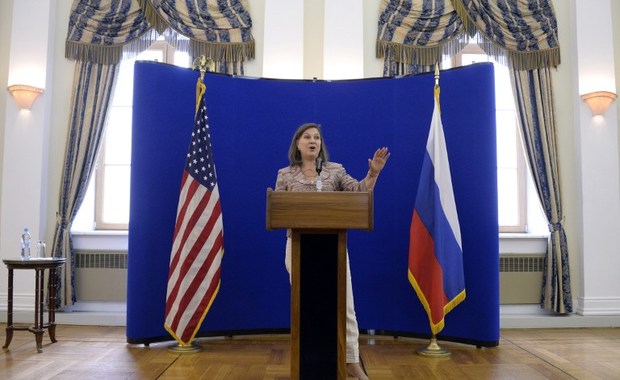
Surkov-Nuland Talks on Ukraine: A Nontransparent Channel (Part One)
Publication: Eurasia Daily Monitor Volume: 13 Issue: 103
By:

Informal discussions are sputtering along between Washington and Moscow over implementation of the Minsk armistice in Ukraine. This bilateral process originated in May 2015 as an accompaniment to the Barack Obama administration’s decision to seek Russia’s “help” on Syria. Assistant Secretary of State Victoria Nuland has been tasked to conduct the unofficial discussions with Moscow about Ukraine, initially with Russia’s Deputy Foreign Minister Grigory Karasin after May 2015 and continuing with top presidential advisor Vladislav Surkov since January 2016. Each side has its own understanding of what the implementation of the armistice, and particularly “full implementation,” means.
Unlike the multilateral “Normandy” format (Germany, France, Ukraine, Russia) and its Minsk Contact Group appendage (Ukraine, Russia, Donetsk and Luhansk “people’s republics,” and the Organization for Security and Cooperation in Europe—OSCE), the bilateral Washington-Moscow channel is not designed for any systematic or comprehensive negotiations. Instead, it pursues what Obama administration officials would call “creative solutions,” or face-saving quick fixes, interim compromises that might look like progress. According to Nuland, on her latest visit in Moscow (Interfax, May 18), this bilateral channel operates “in parallel with” and as a “reinforcement of” the Normandy format, “by agreement with its participants.” However, the Normandy format (for all its flaws) is partly transparent, politically accountable to some extent, and operating on the authority of state leaders. By contrast, the bilateral Washington-Moscow channel is wholly nontransparent, and the higher political authority behind it may be presumed but remains invisible. While the Normandy format deals with “the Ukraine crisis” only, the bilateral Washington-Moscow channel seems at times to deal with both Ukraine and Syria, generating speculation about some “package” solutions in this opaque process.
The political priority in all negotiating formats at this stage is to hold “elections” in the Russian-controlled Donetsk and Luhansk “people’s republics” (DPR, LPR), in accordance with the Minsk armistice and OSCE standards. Nuland has been urging Kyiv to go along with such “elections,” on the assumption that Moscow would allow the ceasefire to take hold. Last month in Kyiv, Nuland called for those “elections” to be held by July, which would demonstrate Ukrainian compliance with the Minsk armistice and persuade the West collectively to prolong the sanctions on Russia. State Department spokesman Mark Toner corroborated this, describing the July voting date as desirable, though not rigid (Dzerkalo Tyzhnia, April 26). In return, Nuland promised (as on her previous visits) that Washington would press for the withdrawal of Russian forces and the restoration of Ukraine’s control along the DPR-LPR-controlled border with Russia, once those “elections” are held (Ukraiynska Pravda, April 25–27).
This chronological sequence is that of the Minsk armistice, but the “obligations” weigh on Ukraine only. Even if Ukraine assents to those elections, Russia has no obligation to follow up by withdrawing its forces or allowing Ukraine to regain control of the border.
According to some insiders to this process, the Surkov-Nuland meeting on January 15 near Kaliningrad had discussed creative solutions that might ease Kyiv’s assent to DPR-LPR “elections.” For example, Russian heavy weaponry would be assembled at certain designated points, under OSCE oversight, in the occupied territory (rather than being withdrawn to Russia). And DPR-LPR personnel would be assigned to serve with Ukrainian border troops in that territory (rather than Ukraine regaining sovereign control of the border) after those “elections” would have been held. Ironically, those two scenarios could result in Russian heavy weaponry and crews being re-flagged as DPR-LPR (to eschew withdrawal to Russia), and DPR-LPR personnel in the border troops being re-flagged as Ukrainian (to claim Russian compliance with the Minsk armistice, once Ukraine will have recognized those “elections”).
All this would in fact be consistent with the letter of the Minsk armistice. That document does not even mention the Russian forces in Ukraine’s east; and it envisages that Kyiv and Donetsk-Luhansk would negotiate (share) control of the Ukrainian side of the Ukraine-Russia border after those local “elections.” These are cautionary signs to Ukraine. Even if Kyiv accepts the proposed “elections” to legitimize the DPR-LPR, and enshrines their constitutional status, no one can guarantee that Russia would reciprocate by withdrawing its forces or allowing Ukraine to regain control of the border.
Nuland met with Surkov and, separately, with Deputy Foreign Affairs Minister Sergei Ryabkov, on May 17–18 in Moscow. Her visit followed upon the meeting between US Secretary of State John Kerry and Russian Minister of Foreign Affairs Sergei Lavrov, two days earlier in Vienna, where they discussed Ukraine and Syria. In Moscow, Surkov is responsible for overseeing the Donetsk and Luhansk “people’s republics,” reporting directly to President Vladimir Putin; while Ryabkov is known to handle the Syria dossier.
In both meetings, Nuland confirmed on President Barack Obama’s authority that “if and when Minsk is fully implemented, sanctions [on Russia] can be rolled back” (Interfax, May 16, 18).
However, all the sides involved differ in their interpretations of the armistice and what may constitute partial or full implementation (see above). In the short term, Ukraine is being urged to accept “elections” in the Russian-controlled territory, thus “implementing” a major phase of the armistice unilaterally. Kyiv is calling, in almost desperate tones, for an OSCE armed police mission to provide security both for the OSCE’s own ceasefire monitors and for the proposed elections (see EDM, April 20, May 20). However, the United States has yet to speak its word on this matter.



